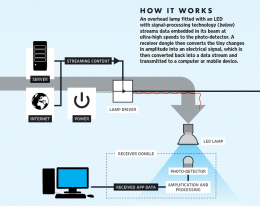October 6, 2012 weblog
Li-Fi: Edinburgh prof seeds LEDs for communication

(Phys.org)—"We believe wireless communications should be as reliable as lighting." That is a company motto of startup PureVLC (Visible Light Communication), which aims to connect the two—communications and light. They have an approach that could be an alternative to radiofrequency spectrum, as there are worries about "running out of gas" because demand grows for space. "We talk about the Internet of Things where every device is interconnected, but without more bandwidth it will be impossible to provide reliable communications to all of these 'things,'" say company sources.
PureVLC has in mind an alternative communications path that could hit 1Gbps wireless speeds. Harald Haas, the company CTO, has said his company is relying on the potential of the use of LEDs for transmitting wireless data, Rather than complex radio schemes at increasingly higher frequencies, "the performance of VLC looks very favorable," said the company. PureVLC intends to commercialize LED systems. The team hopes the technology can be integrated into mobile devices.
Haas is professor of mobile communications at the University of Edinburgh. His team have developed their wireless networking system to handle data transfer using light instead of radio waves. They have been able to transmit and download streamed video using the visible light method, according to a Professional Engineering report published earlier this week. The report looks at this work so far.
The approach is called "Li-Fi," where LEDs are used to transmit data to photo-sensor receivers by making changes in the intensity of light so fast the eye cannot see. The pattern of this flashing light can project the data in the form of 0s and 1s at very high speeds. The data is encoded in the light and transmitted from the light source. He commented that it is not really a case of switching the light on and off but of changing the intensity in a subtle and specific way.
Haas also told Professional Engineering that the company was developing a smart lighting development kit (SLDK) that can enable lighting systems that are already in place to transmit and receive data, reaching network speeds of up to 50 megabits per second. (The SLDK will be capable of downloading and uploading data at speeds of between 15 and 50Mb/s.)
According to the company, the SLDK will enable lighting manufacturers to add "visible light communications" to their products. The kit is designed to enable rapid implementation of VLC technology using standard lighting fixtures.
Haas last year performed the first public demonstration of visible light communications live at TED Global, where he showed an angle poise lamp fitted with an LED bulb transmitting high definition video displayed onto a massive screen. When he interrupted the light with his hand the video froze and it was then restored when he removed his hand.
More information:
purevlc.com/
profeng.com/features/dawn-of-the-age-of-li-fi
© 2012 Phys.org



















